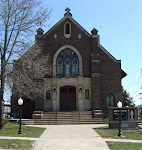Tuesday, August 30, 2011
Tour of the Church Continued
written by Pat Thompson
Tour of the Church ContinuedClick on image to make it larger.
Stations of the Cross
Books could be and have been written on the last few days and moments of Jesus’ life. Most of the following information--very abbreviated--has come from Steve Ray’s cd Stations of the Cross, Pope Benedict’s book Jesus of Nazareth Holy Week: From the Entrance into Jerusalem to the Resurrection and The Catechism of the Catholic Church.
When discussing the Stations it might be helpful to discuss first a bit of history.
Even in the first and second centuries a few pilgrims traveled what has been called Via Dolorosa or the Way of Sorrows, the path Jesus walked on His way to Calvary. Journals have been found from pilgrims writing in the third and fourth centuries about their visits to the holy sites. In 2010 more than three million Christians walked the two and a half miles around Jerusalem through Jewish, Christian, Armenian, and Muslim quarters, all seeking to follow the “Way of the Cross.”
No one knows for certain the exact route Jesus’ was forced to walk, but location of some key places have been determined, in spite of the fact that now people--due to the accumulations of the various societies living there over the centuries--walk about nine feet above the street level where Jesus once walked.
Although people have sought to follow in Jesus’ footsteps since the earliest times of Christianity, the cost and the time it took to travel there inspired St. Francis of Assisi to start the chapel version of the Station of the Cross. Thus we have mounted on the wall of our church fourteen Stations to help us recall and grieve over and give thanks for Jesus’ great sacrifice of love for us.
Over the years there have been anywhere from eleven to thirty Stations but the standard number is now fourteen, or fifteen because of the importance of remembering that the resurrection followed Jesus’ death.
Eight, or nine, of the Stations have a biblical basis Six are not mentioned in the Bible but are reasonable to believe.
To be continued...





